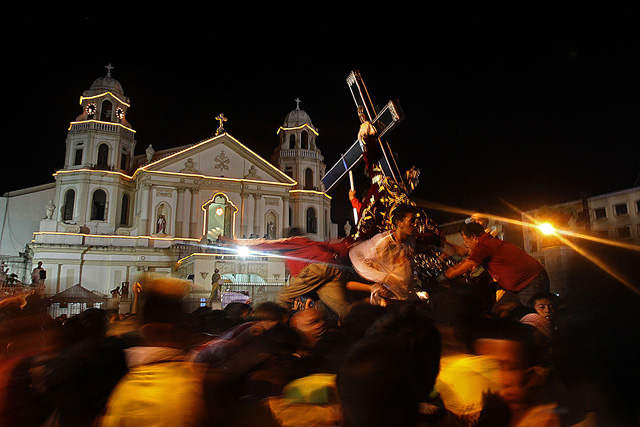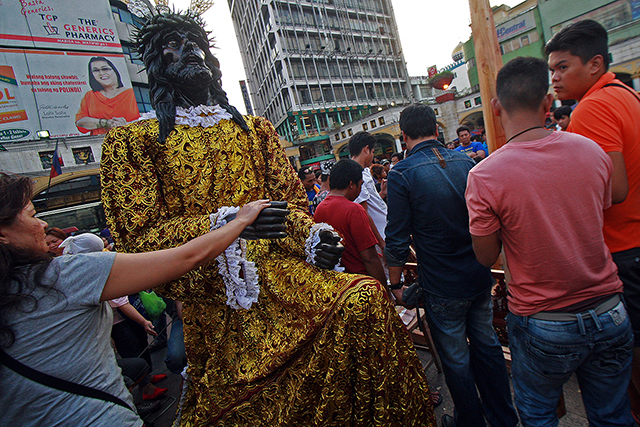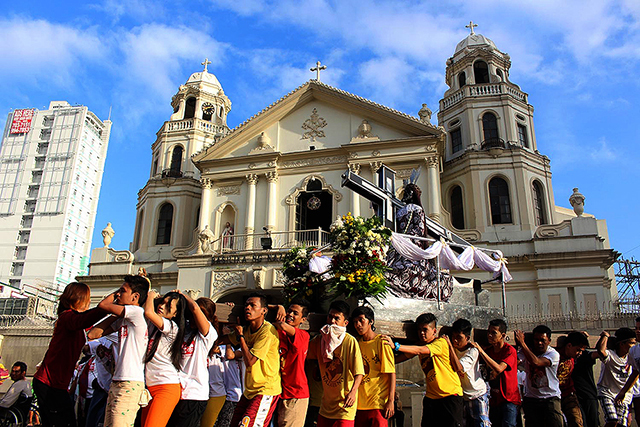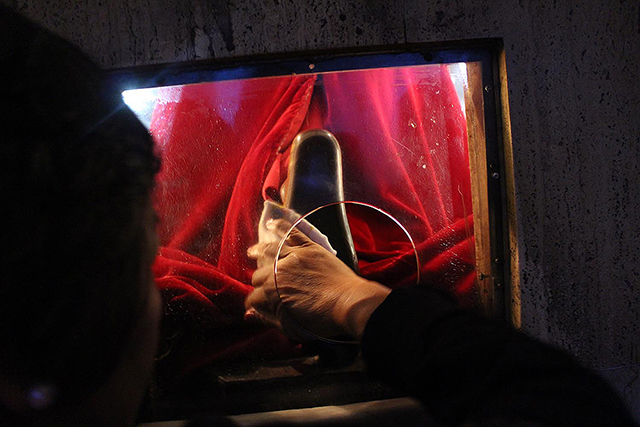Filtered By: Lifestyle
Lifestyle
Black or white: The Nazarene and the Pinoy devotion
By ODI M. DE GUZMAN

Catholic devotees gather outside the Quiapo Church in Manila before dawn on Thursday, January 1, 2015, for the thanksgiving procession for the Black Nazarene. Danny Pata
The Black Nazarene is a life-sized statue of Jesus Christ carrying the cross that is believed to be miraculous. It is housed at the Minor Basilica of the Black Nazarene in Quiapo, a district of Manila across the Pasig river to the north. Every January 9, the statue is taken out of the church for a procession along the streets of Manila. Thousands of mostly male devotees pack the streets as they jostle to get closer to the image to touch it.
According to theologian Msgr. Sabino A. Vengco, Jr. of the Loyola School of Theology, there are myths surrounding the devotion to the Black Nazarene. Vengco says "the ignorance surrounding the Nazareno is remarkable."
Always black
For one thing, he says, the Nazarene never was white. At the core, it has always been black.
The popular belief attributes the statue's dark color to a fire on the ship carrying it from Mexico (during the Manila-Acapulco galleon trade) that charred its originally white skin.
"Hindi po," Vengco asserts.
"In my research—and I have been to Mexico for this purpose—the wood that they used, popular among Mexicans at that period, was the wood of the tree called mesquite. The core of this wood is black like the Philippine kamagong."

Devotees gather near a newly-sculpted 10-ft replica of the Black Nazarene as it arrives in Quiapo Church on Tuesday, January 6, from Paete, Laguna. The image will be paraded along with hundreds of others at the Traslacion on January 9. Danny Pata
Another popular religious icon with a similar dark complexion venerated in the Philippines is the Lady of Peace and Good Voyage, also known as the Virgin of Antipolo. This image was brought to the Philippines from Mexico via the galleon El Almirante sometime in 1626.
Vengco says that the wood used for the Virgin of Antipolo was also mesquite, which "explains why even our Lady of Antipolo, which also came from Mexico, is black."
He added: "Hindi sila nasunog. Yung wood na ginamit ay black, mesquite."
Celebrated on the 'wrong' date?
Vengco also says that January 9 is the wrong date for celebrating the feast of the Nazareno. From a theological point of view, he says it must not be celebrated so early in the year. According to Vengco, January 9 is still part of the purview of the Christmas season. For 2014, the Christmas season officially ended on Sunday January 12 with the Feast of the Baptism of the Lord.
Vengco asks: "How can you be celebrating the birth and the coming of Jesus when already he is there bowed down beneath the weight of the cross?"
"Out of season. That is the verdict," he asserts.
He says the celebration of the Nazareno feast in Quiapo is out of season "in violation of the fundamental principle that any popular devotion must harmonize with the liturgy and must lead the people, the faithful into the liturgy."
"It does not do that, he says. Rather, it has a life of its own. Vengco adds: "it disrupts the season of the Church."
So, why then is the feast celebrated every 9th of January? Vengco says historically, 200 years ago, the image was transferred from Intramuros to Quiapo on Jan 9.

Young devotees from Cutud, Novaliches, Quezon City carry a replica image of the Black Nazarene during a parade of Nazarene images in Quiapo, Manila on Wednesday, January 7. The images will join the Traslacion on Friday. Roy Lozano
He says it was handed over by the Recoletos (Order of Augustinian Recollects or O.A.R.) who, he says, were the original owners of the statue.
According to Vengco: "The statue was originally housed in the church of the Recollects in Intramuros. But the church was destroyed in the big 18th century earthquake and somehow the image was handed under the power of the Archbishop of Manila who then ordered it transferred to Quiapo." He says the historical transfer is now out of proportion since the feast of the Nazarene is now celebrated on the day of the transfer.
Vengco hinted that there was probably some internal politics among the church men involved that led to the Archbishop's order for the transfer of the image from the Recollects to the Quiapo Church.
He points out that religious ignorance "is our main characteristic and that is what we must work on," adding "the ignorance surrounding the Nazareno is remarkable."
So, if not January 9, when then?
According to Vengco the feast of the Nazareno during the Spanish period was celebrated with processions within the walled city of Manila during the Lenten season.
"And that is the correct time for the Nazareno when we are now meditating the sacrifice of our Lord,” Vengco asserts. And he is emphatic when he says that it must be returned to that original date.
How can that be done?
"I have challenged the Recollects," he said. "As the original owners, they know the historical background and context. I've been telling them, come out, publicize the original form of the devotion so that with the spread of knowledge we can gradually correct what is already becoming a monstrous demonstration of what is, in the very core of it, not Christian piety and form."
Popular piety as superstitious, fanatical and even idolatrous

A Catholic devotee touches the foot of the Black Nazarene at Quiapo Church on Thursday, January 8, a day before the Traslacion. Roy Lozano
Even foreigners were lining up to experience the Black Nazarene pahalik.
Wheelchair-bound septuagenarian Virgilio Victoria completed his devotion to the Black Nazarene last January 9, 2014 despite his condition. Unable to walk, Victoria sought and got help from GMA news reporter Ivan Mayrina. "Kung maaari po sana, itong towel na ito'y ipahid niyo sa Nazareno," asked Victoria, holding up a white towel to the camera in a report on GMA News program "News To Go".
Scenes similar to this happen every year as it further strengthens the fanatical devotion to the Black Nazarene.
Desiderio Salvador used to head the organizing committee for the annual procession. “Their faith is strong because all of one’s wishes, one’s petitions are granted by the Senyor,” Salvador explains the crowd’s zeal.
The Padawan disagrees with the Master
However, Msgr. Jose Clemente F. Ignacio, the parish priest of Quiapo Church and a former student of Vengco's, is more circumspect about his thoughts on the popular piety displayed in his parish.
In a symposium at the Loyola School of Theology in September 2011, Ignacio wrote: "We Filipinos believe in the presence of the Divine in sacred objects and places. The people want to be connected to the Divine, be it through the lining up for the Pahalik; or holding on to the vestments of the Nazareno after the Pabihis; or to be able to touch the rope and put it on their shoulders - this is a way of expressing one’s faith. It is an expression of their devotion. We all know we don’t worship statues. We worship God and if these statues would ‘bridge us to God’, then we want to connect with God using these statues. Kissing or holding on to the statues is not worshiping statues, it is connecting to the divine, to touch and be touched by heaven itself."
As one of the pastors of Quiapo Church, Ignacio says that he always faced issues that had to do with the devotion to the Black Nazarene.
"I don’t know, but after being submerged in the life of the ordinary devotees, the pastors of Quiapo are one in the feeling that they have been humbled in their priesthood the more they get to understand and encounter the faith of the simple people. From where ordinary parishioners stand, one can feel the intensity and sincerity of their devotion."

Black Nazarene devotees trooped to Quiapo Church for the first Friday Mass on January 2, seven days before the Black Nazarene Feast on January 9. Roy Lozano
So, at the end of it, does it matter if the wood used for the Nazareno was black or white? Will it affect the devotees' piety if they celebrate the feast on January 9 or during the Lenten season? Will the devotees' belief be less with their folk-based devotion or will it be more potent with a theologically-based celebration?
¿Quién sabe? — BM, GMA News
More Videos
Most Popular




